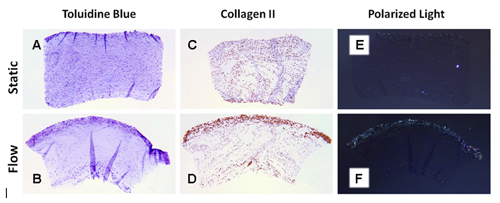Bioreactors for Cartilage Tissue Engineering
Bioreactors are used to optimize various culture factors such as nutrient transport, growth factors, oxygen tension and mechanical stimulation in tissue engineering systems. Some bioreactors have used mechanical stimulation to enhance the synthetic activity of the cells while others have used perfusion fluid flow to enhance nutrient transport and produce homogenous constructs. To date, however, recapitulation of the zonal organization of native cartilage and the associated anisotropy in structure and mechanical properties in engineered constructs remains elusive.

Schematic illustration of the parallel-plate Poiseuille flow bioreactor.
With the hypothesis that interstitial fluid flow induces frictional drag and shear stress that can affect the alignment of fibrillar collagen in the constructs, we developed a Poiseuille flow bioreactor system that induces interstitial flow fields to recapitulate the spatial heterogeneity of native articular cartilage in chondrocyte-seeded agarose hydrogel constructs. Our preliminary results demonstrate that Poiseuille flow-coupled interstitial flow leads to the development of layer that has features of the superficial zone region in engineered cartilage constructs.

Representative micrographs of Toluidine Blue staining, Collagen II Immunostaining, and fibrillar alignment under polarized light of tissue-engineered cartilage hydrogels under static- or flow-conditions.
Researcher: Hani A. Awad, Ph.D.
Musculoskeletal Tissue Engineering
